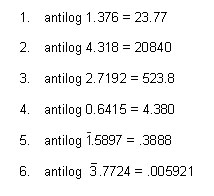If log N = x then N is called the antilogarithm of x and is written as
log N = x ⇒ N = antilog x.
As we have logarithm tables, we also have antilogarithm tables that enable us to find the numbers whose logarithms are known.
|
0 |
1 |
2 |
3 |
4 |
5 |
6 |
7 |
8 |
9 |
Mean Differences |
1 |
2 |
3 |
4 |
5 |
6 |
7 |
8 |
9 |
.00 |
1000 |
1002 |
1005 |
1007 |
1009 |
1012 |
1014 |
1016 |
1019 |
1021 |
0 |
0 |
1 |
1 |
1 |
1 |
2 |
2 |
2 |
.01 |
1023 |
1026 |
1028 |
1030 |
1033 |
1035 |
1038 |
1040 |
1042 |
1045 |
0 |
0 |
1 |
1 |
1 |
1 |
2 |
2 |
2 |
.02 |
1047 |
1050 |
1052 |
1054 |
1057 |
1059 |
1062 |
1064 |
1067 |
1069 |
0 |
0 |
1 |
1 |
1 |
1 |
2 |
2 |
2 |
.03 |
1072 |
1074 |
1076 |
1079 |
1081 |
1084 |
1086 |
1089 |
1091 |
1094 |
0 |
0 |
1 |
1 |
1 |
1 |
2 |
2 |
2 |
.04 |
1096 |
1099 |
1102 |
1104 |
1107 |
1109 |
1112 |
1114 |
1117 |
1119 |
0 |
1 |
1 |
1 |
1 |
2 |
2 |
2 |
2 |
.05 |
1122 |
1125 |
1127 |
1130 |
1132 |
1135 |
1138 |
1140 |
1143 |
1146 |
0 |
1 |
1 |
1 |
1 |
2 |
2 |
2 |
2 |
.06 |
1148 |
1151 |
1153 |
1156 |
1159 |
1161 |
1164 |
1167 |
1169 |
1172 |
0 |
1 |
1 |
1 |
1 |
2 |
2 |
2 |
2 |
.07 |
1175 |
1178 |
1180 |
1183 |
1186 |
1189 |
1191 |
1194 |
1197 |
1199 |
0 |
1 |
1 |
1 |
1 |
2 |
2 |
2 |
2 |
.08 |
1202 |
1205 |
1208 |
1211 |
1213 |
1216 |
1219 |
1222 |
1225 |
1227 |
0 |
1 |
1 |
1 |
1 |
2 |
2 |
2 |
3 |
.09 |
1230 |
1233 |
1236 |
1239 |
1242 |
1245 |
1247 |
1250 |
1253 |
1256 |
0 |
1 |
1 |
1 |
1 |
2 |
2 |
2 |
3 |
.10 |
1259 |
1262 |
1265 |
1268 |
1271 |
1274 |
1276 |
1279 |
1282 |
1285 |
0 |
1 |
1 |
1 |
1 |
2 |
2 |
2 |
3 |
In the first column, the numbers represent the first two digits of the mantissa of the logarithms, the numbers 0,1,2 ..... 9 at the head of the next ten columns denote the third digit in the mantissa. The numbers under the head “Mean Difference” denote the approximate increase in the value because of the fourth significant figure. The number of digits before the decimal point or the number of zeros before the first significant figure of the required number and after the decimal point is fixed with the help of the characteristic.
Example 7
Find x if log x = 3.0195 or find the antilog 3.0195
Ignoring the characteristic, we consider only the mantissa.
To obtain x, consider the number in the row containing .01 under the head of 9, which is the third significant figure, and increase it by the value given under the head of 5 of the mean difference.
We obtain the value 1045 + 1 = 1046
The number whose mantissa is .0195 contains 1046 as the first four significant figures. The characteristic is 3 so x contains four digits before the decimal point, or x = 1046.
Example 8
Determine x if log x = 1.1098, mantissa = .1098
Consider the number in the row containing .10 under the head of 9 the third significant digit and increase it by the number given under 8 of the mean difference for the fourth significant digit.
We get the value 1285 + 2 = 1287
The number whose mantissa is .1098 contains 1287 as the first four significant figures. The characteristic of the log is 1. So x contains two digits before the decimal point or x = 12.87.
Example 9

There are four digits in the mantissa. Consider the number in the row containing .09 under the head 6 for the third significant digit and increase it by the number given under 8 of the mean difference for the fourth significant digit.
We get the value 1247 + 2 = 1249
The number whose mantissa is .0968 contains 1249 as the first four significant figures. The characteristic of the log is 4.
So x contains three zeros after the decimal point.
So x = .0001249.
Example 10
Find x if log x = 0.107713
Since there are more than four decimal places in the mantissa, we round it off to the fourth decimal place.
So .107713 = .1077
Consider the row containing .10 under the head of 7 for the third significant figure and again under the head of 7 of the mean difference for the fourth significant digit.
We thus have the number 1279 + 2 = 1281
So, the four significant figures of the required number whose mantissa is .1077 is 1281. The characteristic is 0 so there is one digit before the decimal point, or x = 1.281.
We will now use our knowledge of logarithms and antilogarithms to solve numerical problems.
Example 11
Evaluate

Solution
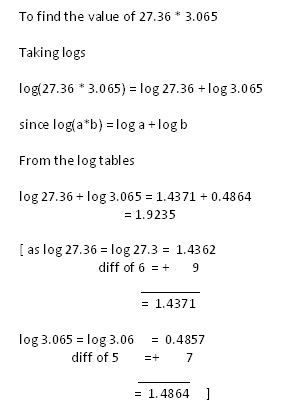
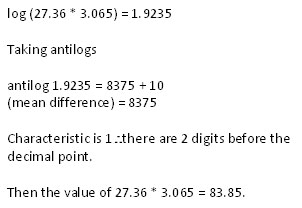
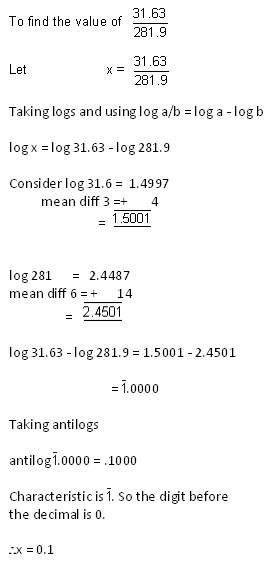
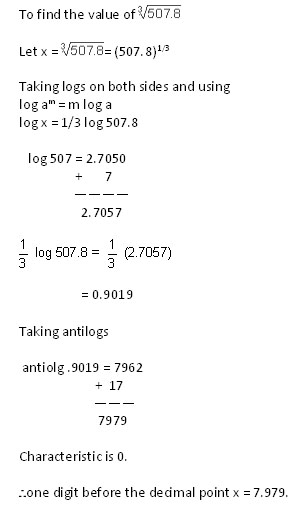
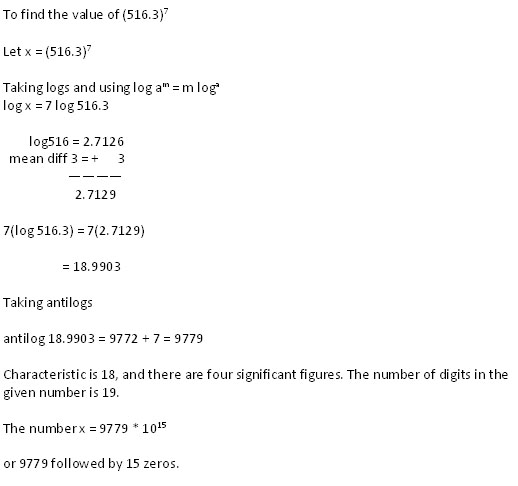
Example 12

= 0.4579 + 1/3(1.5857) + 2(0.54.3) - 1.3298
- 1/5(1.5962)
= 0.4579 + 0.5286 + 1.0806 - (1.3298 + 0.3192)
= 2.0671 - 1.6490
= 0.4181
Taking antilogs
antilog 0.4181 = 2619
x = 2.619.
Remember
While finding the antilog, take only the mantissa part, which is the decimal part. Never include the digits of the characteristic, which is the digit before the decimal point.
Try these questions
Find the antilogarithms of the following

Answers
